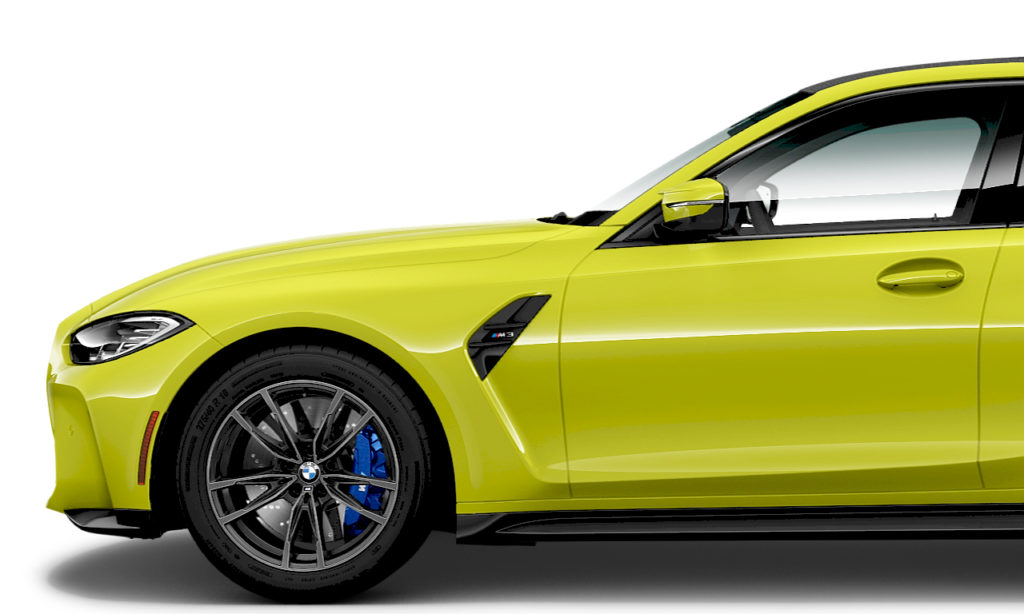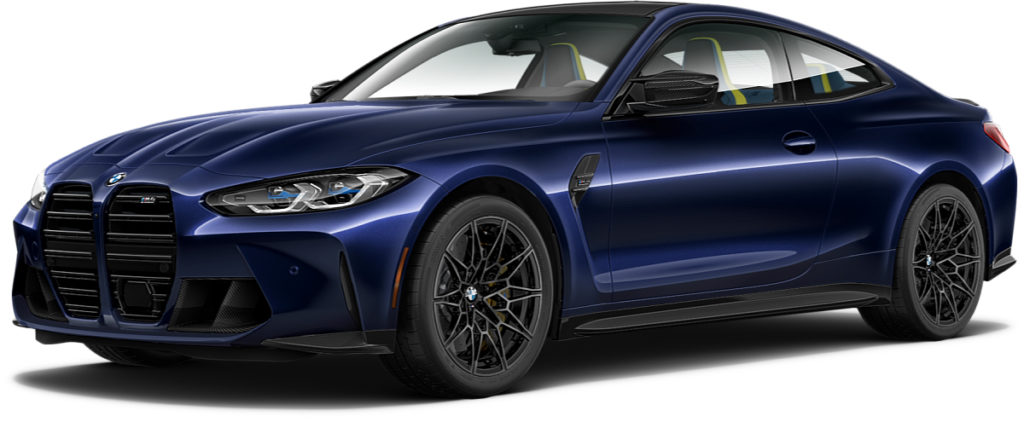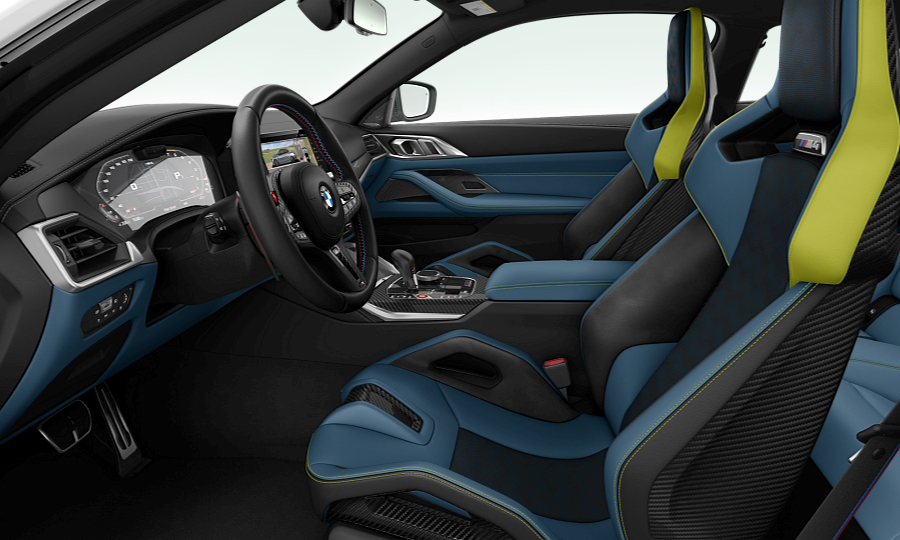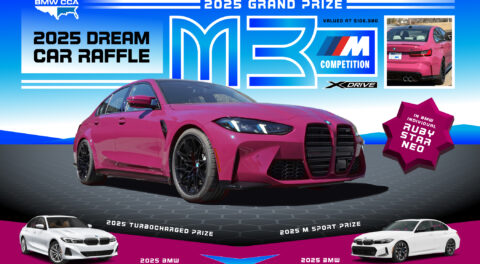Configurators for the new G80 M3 and G82 M4 have been added to the BMW USA website. That means you can go build one for yourself—in the virtual sense—and see how the updated array of color options influence the bold front-end styling of both models. The first M models to be offered in two distinct variations at launch, the upcoming M3 and M4 can be had in either 473-horsepower base-model form, or 503-horsepower Competition spec. Power for either model comes from the same engine, the S58 M inline-six, but if you want a six-speed manual—and BMW is essentially the only manufacture left producing a vehicle with such an archaic apparatus in this segment today—you’ll have to go with the less powerful version. It’s a similar story with M xDrive; if you consider all-wheel drive mandatory—which it may very well be with 503 horsepower and 479 pound-feet of torque—you’ll want a Competition variant, and as of this writing, you’ll also have to wait until roughly next summer, when xDrive joins the M3 and M4 lineup for the first time.
All of this means that there is a distinct dichotomy between how you can specify the new M3 and M4, and it couldn’t be more apparent in terms of price.

Start checking the boxes for various options and packages, and it’s not necessarily easy to surpass the six-figure mark for the MSRP of a new M3 or M4, but it is most certainly possible. On the same coin, however, the M3 and M4 already come very comfortably-equipped, as the dealer advertisements say, meaning it’s not particularly imperative to check single box for a fully-loaded car.
Stick to the basics—you know, those underlying tenets that initially drew many of us to BMW in the first place—and you’ll find the four-door M3, specifically, can be a relative bargain when lined up against the competition, both internal and external. Take the Sao Paolo Yellow example I built for this article. Can you believe such a wild finish is a no-cost option? Pretty neat considering it’s one of the launch colors. In terms of packages and add-ons, I kept things as simple as possible. I started with a non-Competition base-model and stayed there, so I could get a six-speed manual. When it came time for wheels, I maintained the minimalist approach, by selecting the staggered—in terms of diameter these days—set of eighteen and nineteen-inch M double-spoke Orbit Grey style 824M wheels with traditional performance tires—there are no run-flat options for the new M3 or M4.
Sadly, it seems BMW nixed the partial cloth interior upholstery choice that was offered for the outgoing F80 M3 and F82 M4. The next best thing in the opinion of a purist will likely be black extended Merino leather, which comes at no additional cost. Aluminum Tetragon trim is nice too, and it’s another zero-dollar line-item on the build sheet. The only option I selected was M drive professional for $900, which seems only natural for a so-called stripper-spec model like this, which is likely to see track time. M drive professional adds what BMW refers to as an M lap timer, M drive analyzer, and additional performance data to the displays.
This stripped down—but incredibly striking—six-speed M3 came to just $70,800 excluding destination. It goes without saying, but it’s a lot of car for the money, and it’s great that BMW is going to be selling an M3 in 2021 with three pedals.

The M4 starts at $71,800 compared with the $69,900 base price of the M3, so it was only practical to use it as the basis for a fully-loaded, maxed-out configuration. Something about the coupe body style also seems to lend itself to a more premium presence, with the long doors doing much of the talking. If you want the full experience, the 500-horsepower M4 Competition is the one to go with, and it comes at a $2,900 premium to the garden variety, with a starting MSRP of $74,700.

Although the metallic paint colors for the M4 come at a cost of $550, opting for one of the factory-offered BMW Individual colors costs substantially more. You have a choice between Dravit Grey Metallic and Tanzanite Blue II, and having seen the latter in person numerous times, exhibiting its strong transformative property under varying light, it was no contest. Competition models already come upgraded with upsized wheels, so all of the choices in the current lineup come at no additional cost. BMW M has picked up where it left off in terms of Competition wheel designs, and the latest M3 and M4 can be had with what looks like a refined and evolved version of the style 666M wheels first seen on the F82 M4 when equipped with the competition package, and the yet-to-be-succeeded F82 M4 GTS, which is essentially a race car for the street. The new design come in staggered fitment with a diameters of nineteen and twenty inches front and rear respectively, and are branded as style 826M M double-spoke bi-color wheels.
The new M3 and M4 come standard with a nice set of sport seats, but for $3,800, you can upgrade to the optional M carbon bucket seats. They look exceptional on their own (who needs map pockets?) but upholstering them in some eye-catching model-exclusive leather enhances things further. In the case of my example M4 Competition, it’s Yas Marina Blue and black full Merino leather with a yellow accent. The upholstery alone goes for $2,550, and covers surfaces such as the dash, kick panel, center console, and elsewhere. If you’re going for the M carbon bucket seats, there’s obviously no skipping the optional carbon-fiber trim, which adds $950 to the bottom line.

To prove the point of this M4 Competition build, there really isn’t much point in skipping some of the tech which rounds out such a cutting edge vehicle. Driving assistance professional package costs $1,700 and essentially allows the M4 to drive itself through traffic jams, and adds the full suite of radar sensors and cameras. If you’re adding driving assistance, it doesn’t make much sense to skip the $800 parking assistance package, which is made up of parking assistant plus, which parallel parks the car for you, and the drive recorder, which can be used to record the vehicle’s surroundings at all times, with supporting data such as speed, GPS, and more. The $3,000 executive package is the most expensive of the three packages available for the M4 Competition, but adds neat stuff like remote engine start, gesture control, adaptive LED headlights with laser light, a heated steering wheel, wireless smartphone charging and a wifi hotspot among more.
It’s the individual options that really begin to add up, but if you’re already shelling out for the M carbon bucket seats and the interior carbon-fiber trim, why not complete the trifecta with the M carbon exterior package? For a mere $4,700, your M4 Competition can come delivered with carbon-fiber pieces such as mirror caps, a rear spoiler and diffusor, and front and side air inlets. M drive professional for $900 (explained above in the context of the M3 build) makes yet another appearance, while the aforementioned upsized wheels house M carbon-ceramic brakes, an $8,150 option.
Arriving on the summary page of the M4 Competition configurator, the total MSRP for the car described above came to $103,200. That’s $32,400 more than the stripped-down Sao Paolo Yellow M3 I first configured, and such a wide differential begs the question, is it really worth it? At this early stage, no one has yet performed a comprehensive, side-by-side comparison of each model and shared it with the public, but it’s not outside the realm of possibility to expect the new M3 and M4 to behave and feel substantially different depending on specifications. The horsepower and torque gap between the standard and Competition models is substantial enough to make a significant difference in performance, something that is only compounded by Competition cars coming exclusively with a model-specific version of the ZF eight-speed automatic transmission. Just wait until M xDrive enters the picture next year, which will not only add a few thousand dollars to the MSRP, but also elevate performance to a new level in comparison with rear-drive models and previous generations of the M3 and M4.—Alex Tock

[Photos via BMW NA.]





















